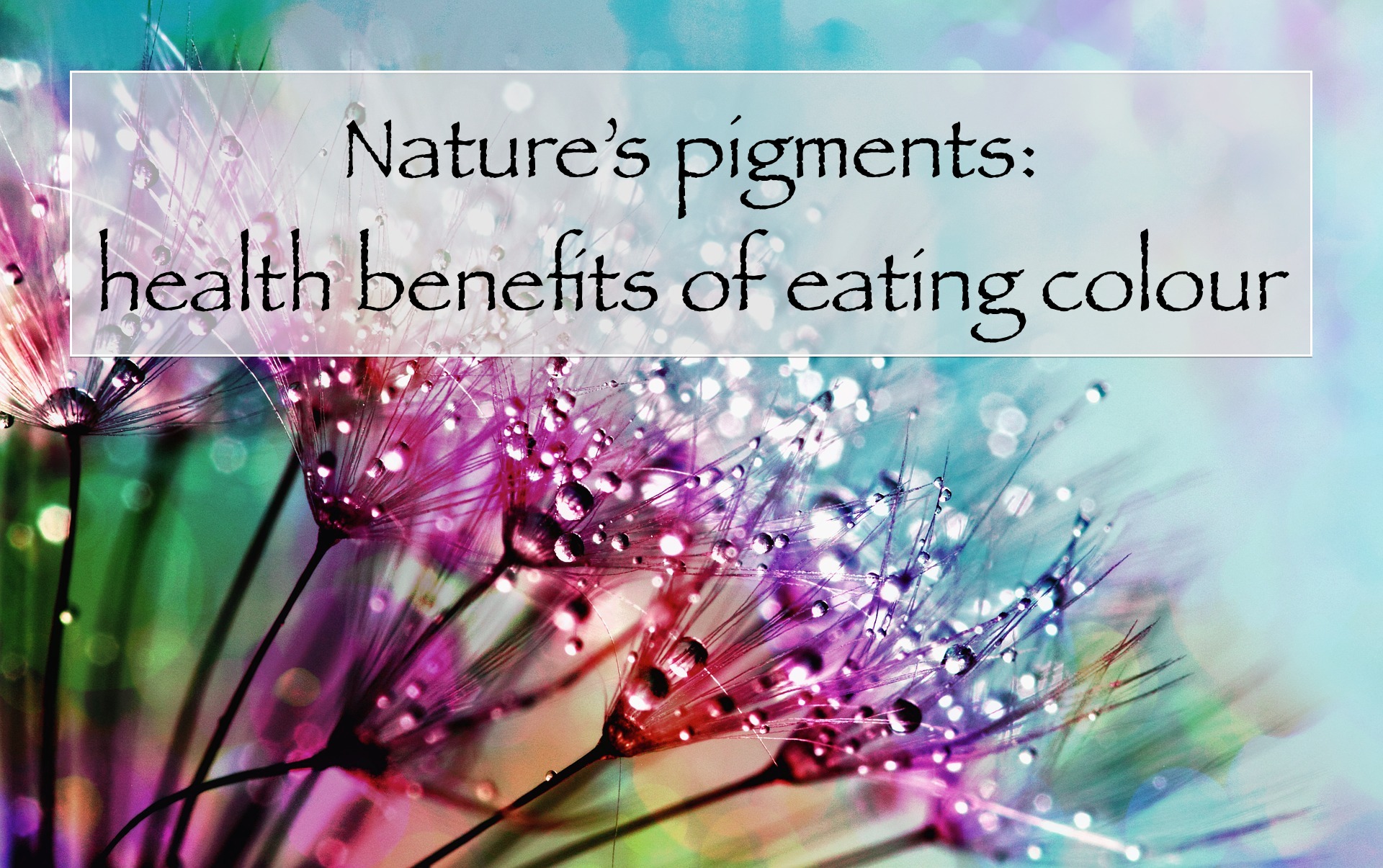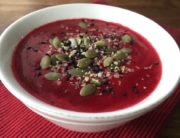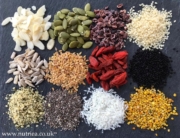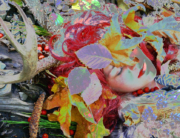The term ‘eat the rainbow’ is now well established but do you know exactly why all those different colours matter so much?
The colour pigments that give foods those vibrant colours are incredibly beneficial to health and each has their own properties. Given the great synergy between these compounds a little of each will provide the greatest benefit, but based on your personal circumstances you may need a little more of some. Here’s what they do…
RED: Lycopene, Betalain, Ellagic acid & Astaxanthin
Lycopene is a powerful antioxidant from the carotenoid family of phytochemicals that gives foods a red or pink colour and has been shown to be effective to reduce risk of cardiovascular disease and cancer, and as an antioxidant it’s anti-ageing too. Tomatoes are the most well-studied source and lycopene appears to be very stable and not affected by cooking. As a fat-soluble antioxidant it requires some fat with it to absorb effectively, so drizzling some olive oil on your tomatoes ensures better results. Other lycopene-rich foods include watermelon, pink grapefruits and guava.
Ellagic acid is a phenolic compound with powerful antioxidant effects believed to be anti-cancer, anti-inflammatory and cardioprotective. The best food source is wild strawberries (the tiny ones), which aren’t easy to get unless you grow your own, so other good sources include raspberries, pomegranates, strawberries and cranberries. Ellagic acid is also found in walnuts and pecan nuts.
Betalains are most concentrated in beets, but also occur in the red stems of Swiss chard and rhubarb. They have potent anti-inflammatory and antioxidant effects. Betalain also contains nitrogen which naturally increases nitric oxide levels making betalain beneficial for cardiovascular health as nitric oxide reduces hypertension and improves endothelial function – the endothelial cells are those lining the inside of blood vessels. This function also improves blood flow to the brain making betalain good for cognitive function. Betalains are divided into 2 categories: betacyanin which is red-violet and betaxanthin which is more yellow. You may have seen this in the red and yellow coloured stems of rainbow chard and also in yellow beets. Betalains are water-soluble pigments so can be lost during cooking, so try to steam or eat beets raw for best effect.
Astaxanthin is possibly the most potent antioxidant on offer here and is a marine pigment derived from microalgae. The algae makes astaxanthin to protect itself from intense sunlight when the water dries up and exposes it to dangerous UV radiation. We can consume this pigment also via the sea creatures that eat it such as salmon and prawns and it’s this marine pigment that gives these animals their pinkish colour. As a xanthophyll carotenoid, astaxanthin can cross the blood-brain barrier and the blood-retinal barrier allowing antioxidant activity to reach the eyes and the brain. This makes it great for eye health and neurodegenerative diseases like dementia and Alzheimer’s. It can also boost the immune system, support cardiovascular health, reduce inflammation and protect against sunburn. Athletes also use it for endurance – consider the strength and endurance needed by salmon to swim upstream against the currents for days, their muscles are full of astaxanthin. As with all the carotenoids, this is a fat-soluble pigment so requires fat and bile salts to absorb.
ORANGE: Alpha-carotene & Beta-carotene
Carotenes are a subset of the carotenoids and the most well known of the orange-coloured carotenes are the antioxidant compounds beta-carotene and alpha-carotene which are also known as provitamin A as they can be converted into retinol (vitamin A) as needed. This makes them great for eyes, skin and protection against free radicals. Lycopene is also a carotene and although it has more powerful antioxidant activity than these carotenes, it does not convert to retinol. Carotenes absorb UV and blue light protecting plants from the damaging effects of UV light from the sun, and so when we eat them, these benefits are passed on to us. Carotenes are fat-soluble so absorption is enhanced when eaten with healthy fats. Alpha-carotene has more potent antioxidant activity while beta-carotene is better at converting to retinol. There were studies showing beta-carotene supplements were not effective (and even detrimental) for lung cancer, whereas carotene-rich foods were beneficial, and this is believed to be due to the isolated use of this one carotene blocking uptake of the other more anti-oxidative carotenes. This highlights the advantages of getting these pigments from foods where there is a balance of multiple carotenes together.
Beta-carotene is also beneficial to the female reproductive system. Beta-carotene is found in very high concentrations in the corpus luteum of the ovary. The purpose of the corpus luteum is to switch production of oestrogen during the first half of the menstrual cycle to progesterone and oestrogen in the second half. The beta-carotene helps proper function of the corpus luteum and low beta-carotene is linked to delayed ovulation and therefore decreased progesterone levels. This is why beta-carotene benefits conditions related to oestrogen dominance including ovarian cancer, ovarian cysts, heavy menstrual bleeding and breast cysts (cystic mastitis).
YELLOW: Lutein and Zeaxanthin
The group of phytochemicals called carotenoids is split into two groups: the carotenes which are orange in colour and are pure hydrocarbons, and the xanthophylls which are yellow and contain oxygen. The name comes from the Greek xanthos ‘yellow’ and phyllon ‘leaf’. The main xanthophylls are lutein and zeaxanthin, which are both very important for the eyes, especially the macula which is yellow in colour due to it’s concentration of xanthophylls there. Xanthophylls have a chemical structure that allows them access across the blood-retinal barrier, which other carotenoids cannot do. The reddish-pink marine xanthophyll astaxanthin has similar functions to lutein and zeaxanthin.
Being yellow in colour means they absorb ultra violet light really well – yellow is the opposite colour to violet on a colour wheel – the colour we see is what is reflected back after other colours are absorbed. UV light is damaging to our eyes and this is why xanthophylls protect against macular degeneration and other eye conditions. Xanthophylls also help repair DNA, reduce inflammation and boost the immune system.
Xanthophylls as their name suggests are mostly found in leaves, where they are hidden behind the green pigment chlorophyll. When the chlorophyll breaks down then the green fades and the leaf appears yellow – these are the xanthophylls. If you’ve ever left green leafy vegetables in the fridge too long you’ll notice they go yellow. The yellow pigment in egg yolks are xanthophylls too and come from the chicken’s diet – feeding the hens yellow corn will lead to more intense yellow yolks.
GREEN: Chlorophyll
The green pigment in foods comes from chlorophyll, which gets it name from the Greek for ‘green leaf’. Chlorophyll acts as a natural deodorant and can help improve bad breath, halitosis and odours from the back of the throat and mouth. It can also reduce body odours, faecal odour and flatulence odour, so overall makes you smell lovely.
Chlorophyll also acts as a detoxifier as it binds to toxins including heavy metals to render them inert so they can be eliminated from the body. The chlorophyll molecule resembles the haemoglobin molecule in our blood except that the iron in the centre is replaced with magnesium in chlorophyll. This makes chlorophyll a great blood builder. Chlorophyll also boosts blood by stimulating bone marrow where blood cells are made – the increase in red blood cells means more oxygen gets around your body, and the increase in white blood cells boosts immunity. Chlorophyll also assists the immune system as an anti-microbial and is particularly effective against Candida albicans. As a powerful antioxidant it also reduces oxidative stress, which is an underlying mechanism in many chronic diseases including cancer.
BLUE: Phycocyanin
From the Greek word ‘Phyco’ meaning algae and ‘cyanin’ meaning blue, this is a very rare blue pigment found in algae’s like spirulina and blue-green algae. Being so ancient, these algaes had to protect themselves from ultraviolet radiation early in Earth’s history – when interestingly plants were mostly blue instead of green, possibly due to lower levels of oxygen and as a precursor to photosynthesis using chlorophyll.
Belonging to the phycobiliprotein family, this intense blue pigment captures light energy for use in photosynthesis. Phycocyanin is immune enhancing, anti-inflammatory, has great antioxidant activity and scavenges free radicals from damaged nerve cells. It’s protective for the liver and kidneys and has anti-cancer activity as it blocks proliferation of cancer cells. It’s also a great anti-ageing pigment.
PURPLE: Anthocyanins
These are the blue-purple pigments found in many foods, the darker and deeper the hue the higher the concentration of this powerful antioxidant compound. These blue-purple pigments, that can appear black in some foods, such as blackberries and the skins of aubergines, are very valuable for healthy ageing. They help improve memory function, can reverse age-related short-term memory loss, reduce risk of cancer and heart disease, support healthy blood pressure and are good for blood vessels. They are anti-diabetic, anti-microbial, anti-inflammatory and anti-obesity.
Highest levels of this phytochemical are found in the outer layers of the plant, where they are used to protect the plant from UV light, pathogens, oxidative damage and harsh weather. They are water-soluble pigments that are influenced by pH and temperature. They are red in acid and turn more blue with increasing pH. This is evident with red cabbage which turns bright red when raw in a salad with vinaigrette and blue when cooked in mineral-rich water.
There are many blue-purple foods rich in anthocyanins including berries, red cabbage, purple potatoes, purple carrots, purple kale and you can find anthocyanins in blue edible flowers like cornflower and rosemary flowers too.
WHITE: Anthoxanthins
Anthoxanthins are white or cream coloured flavonoids. They are water-soluble pigments giving the colour to foods like cauliflower, parsnip, onions and potatoes. With prolonged cooking a chemical reaction turns the pigment grey – you may have seen this with overcooked potatoes. These compounds also turn whiter in acid and more yellow in the presence of alkaline.
Research shows us that anthoxanthins may reduce stroke risk, promote heart health, prevent cancer, and reduce inflammation. They also seem able to reduce the amyloid plaques in the brain associated with Alzheimer’s disease. One of the best known anthoxanthins is quercetin, found in onions and apples. Quercetin also has an antihistamine effect by helping stabilize histamine-releasing cells in the body, adding to it’s anti-inflammatory benefits.
Another cream-coloured pigment is kaempferol which is also found in apples and onions and works synergistically with quercetin as an anti-cancer compound. Kaempferol appears to inhibit cancer cell growth and trigger cell death in cancer cells while protecting normal cells. For this reason it seems to be beneficial used alongside cancer drugs too.
Summary
The vibrant pigments nature provides can really take our health to the next level. They are not considered essential nutrients but they certainly are hugely beneficial for anyone wanting the best level of health they can get. Eating a variety of colours can be used as preventative medicine and with the synergy between the various carotenoids, flavonoids and other phytochemicals variety is best. Although if you’re looking for specific support to personalise your diet, such as eye health which is supported best by xanthophylls that cross the blood-retinal barrier into the eyes, or carotenes for skin health, or chlorophyll for extra detoxification, then you may want to add in a little extra of those colours on top of your rainbow.
References
Gajowik A and Dobrzyńska MM (2014) Lycopene – antioxidant with radioprotective and anticancer properties. A review. Rocz Panstw Zakl Hig. 65:26371.
https://www.ncbi.nlm.nih.gov/pubmed/25526570
Cheng HM et al (2017) Tomato and lycopene supplementation and cardiovascular risk factors: A systematic review and meta-analysis. Atherosclerosis, 257:100-108.
https://www.ncbi.nlm.nih.gov/pubmed/28129549
Tom Clifford T et al (2015) The Potential Benefits of Red Beetroot Supplementation in Health and Disease. Nutrients, 7: 2801–2822.
https://www.ncbi.nlm.nih.gov/pmc/articles/PMC4425174/
Bethany Grimmig B et al (2017) Neuroprotective mechanisms of astaxanthin: a potential therapeutic role in preserving cognitive function in age and neurodegeneration. GeroScience, 39: 19–32.
https://www.ncbi.nlm.nih.gov/pmc/articles/PMC5352583/
Böhm F et al (2012) Interactions of dietary carotenoids with singlet oxygen (1O2) and free radicals: potential effects for human health. Acta Biochim Pol. 59:27-30.
http://www.actabp.pl/pdf/1_2012/27.pdf
Widomska J et al (2016) Can Xanthophyll-Membrane Interactions Explain Their Selective Presence in the Retina and Brain? Foods, 5(1).
https://www.ncbi.nlm.nih.gov/pubmed/28231102
Jiang L et al (2017) Phycocyanin: A Potential Drug for Cancer Treatment. J Cancer, 8: 3416–3429.
https://www.ncbi.nlm.nih.gov/pmc/articles/PMC5687155/
Eng Khoo H et al (2017) Anthocyanidins and anthocyanins: colored pigments as food, pharmaceutical ingredients, and the potential health benefits. Food Nutr Res. 61:1361779.
https://www.ncbi.nlm.nih.gov/pmc/articles/PMC5613902/
Pate KM et al (2017) Anthoxanthin Polyphenols Attenuate Aβ Oligomer-induced Neuronal Responses Associated with Alzheimer’s Disease. CNS Neurosci Ther. 23:135-144.
https://www.ncbi.nlm.nih.gov/pmc/articles/PMC5239747/
Ackland ML et al (2005) Synergistic antiproliferative action of the flavonols quercetin and kaempferol in cultured human cancer cell lines. In Vivo, 19:69-76.
http://iv.iiarjournals.org/cgi/pmidlookup?view=long&pmid=15796157







Leave A Comment